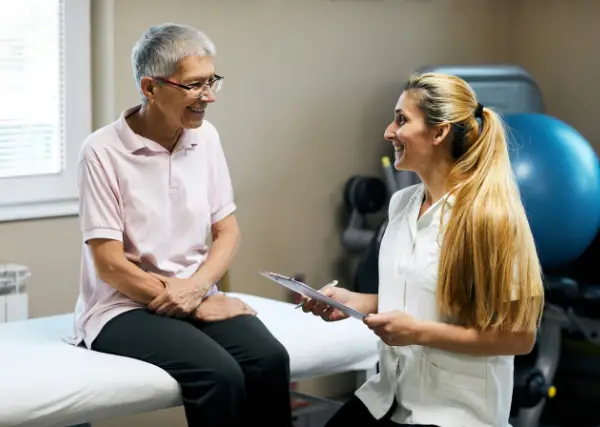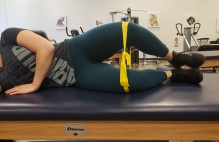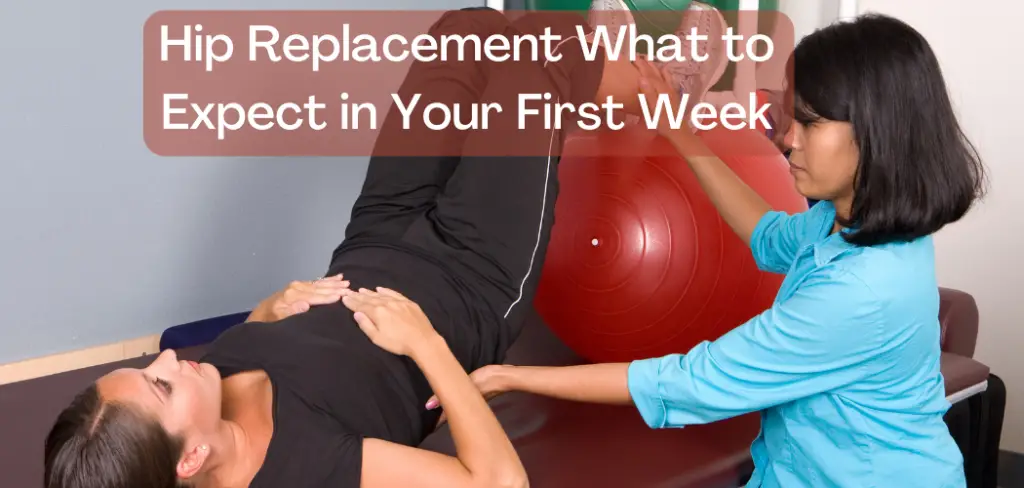If you are one of the thousands of people who have recently undergone hip replacement surgery, you may be wondering what to expect during your first week.
Recovering from hip replacement surgery can be a bit challenging, but with some planning and hard work, you will be on your way to a full and speedy recovery!
In this article, we will discuss everything you need to know about your first week after hip replacement surgery.
Managing Expectations of the First Week
The first week after a hip replacement is a roller coaster. There is excitement because you just had surgery, but there is also a looming fear of the long road to a full recovery.
Unfortunately, surgeons often undersell how hard the recovery can be after a hip replacement.

Surgeons follow up with their patients 6-weeks or 3-months after the surgery and often don’t see or quite understand people’s struggles during that period.
That’s why it’s critical to manage realistic expectations after a hip replacement.
The best advice that we like to give patients is that you have to be patient. It takes time for everything to heal. Let’s put it all into perspective.
During the total hip replacement surgery, the surgeon had to dislocate your hip to get access to the correct location. Then cut through muscles, tendons, and ligaments, and saw off the bones’ end. Not only that, but then they hammer a prosthesis into the Femur bone.
Now, if you have a small break in your arm or leg, you would be in a cast for 6-8 weeks before you could start to move and strengthen it.
Why would you expect a surgery so involved, as we just mentioned, to heal anywhere near 6-8 weeks??
It will take closer to 12 weeks to feel healed and up to a full year after surgery before you feel “normal.”
Remember that analogy every time you start feeling down or are behind progress-wise.
Controlling the Pain and Swelling
The first week is all about controlling the pain and swelling.
Most people report that the first 1-2 days aren’t that bad but the following three days up to 14 days after surgery are the hardest in terms of pain. You will be given a lot of pain medication in the hospital to help with this.
However, one of the best ways to manage pain is to get up and move.
Movement, especially walking and gentle range of motion exercises, help decrease joint stiffness and speed up healing.
It may seem contradictory, and mentally you may feel that you need to sit and rest to allow for healing, but it’s just the opposite.

The more you move and work the hip (within reason), the more the body will adapt and recover faster.
For example, if our ancestors got hurt and sat around, they’d have been eaten by a large predator.
Our bodies must keep moving for safety and food gathering even after serious injuries. They heal in such a way for movement to be medicine.
The safe joint movement will also help push swelling out of the area. The muscle contractions “wring out” or push the swelling out of the joint and into the lymph and veinous system to help manage it.
Other proven ways to help with swelling and pain are leg elevation, compression, light massage, heat packs, and topical pain creams.
Starting and Even Asking for Physical Therapy
You will likely start physical therapy (PT) on the day of surgery or the day after.
The main focus will be learning how to walk again, strengthening your hip muscles, and decreasing pain and inflammation.
Surprisingly, you may even have to ask to go to Physical Therapy. A recent research study showed that walking after a hip replacement was as effective as 2-years after surgery.
However, those that did Physical therapy had quicker strength gains and more confidence in their activities.
We also suspect a quicker return to higher-level activities such as hiking and low-impact sports.
Therefore, you may have to ask your surgeon for a referral to physical therapy instead of automatically being given one.

Even if you go to PT and they evaluate you and only see you 2-3 visits total, at least you can know that you are progressing as expected.
Physical Therapy typically goes for 4-8 weeks to focus on normalizing your gait, improving your hip strength, and helping you get back to your normal levels.
Focus on Walking as Normal as You Can….. as Soon as You Can
One of the most important things you can do for your hip is walk as normally and quickly as possible.
During the first week, you’ll be using a walker to walk. Most people are reluctant to use a walker, but it is crucial to use it during this time to avoid complications in the future.
Most patients use a walker for 2-3 weeks after surgery or until they can walk normally without a limp.
DON’T TRY TO RUSH OFF THE WALKER
Walking normally should be a focus on this from day one after surgery. It will help with pain and swelling and prevent severe muscle spasms down the road.
Expert Tip: Try walking backward and holding on to the counter. Walking backward helps us normalize our gait quicker and improves limping easier than walking forward immediately after surgery.
Be Aware of the Mental Challenges of a Hip Replacement
The mental challenges after hip surgery are real and should not be underestimated.
You will likely experience some level of depression and anxiety after surgery. This is normal and to be expected.
It can be overwhelming as you adjust to a new hip, manage pain, start physical therapy, and try to heal.
The most challenging time will be around 10-15 days after surgery because you are starting to do more. After all, you are healing, and this creates an increase in pain.
This increased pain scares people.
Patients also feel that they should be further ahead than they are, even though its takes weeks and months to heal from major surgery.
Helpful Tips To Combat Post-Surgical Mental Challenges.
First, know that recovery is a mental roller coaster, and feeling overwhelmed is okay. It helps to join groups either on Reddit or Facebook where people have had a similar surgery to read about their experiences.
Review and write realistic timelines and goals for yourself. Setting goals for specific periods after surgery will help manage expectations and keep you motivated. Please make sure they are practical and not something like running after week 2 from surgery.
Lean on family and friends for support as much as you can. You don’t have to cook, clean, or do yard work. This is a time to focus on healing and getting better, don’t stress about the small stuff.
Go to physical therapy or ask for a referral so that you can ask all of the burning questions about recovery. The more questions you get answered by an expert, the more confidence you will have in your hip replacement.
Get a physical therapist you trust and feel comfortable with to help guide you during this time.
Expert Tip: You may not need that many visits to Physical Therapy. Ask your therapists how many visits you’ll need and what you can do at home.
Expert Tips from a Physical Therapist for Making a Full Recovery After a Hip Replacement
Staying Active is Key to a Speedy Recovery
The last tip for having a speedy recovery is to stay active.
This may seem counterintuitive, but staying active will help you recover quicker than if you just rested in bed all day.
Staying active will help with your mental state, increase blood flow to the hip area, which helps with healing, and prevent blood clots from forming.
Get an exercise bike for a hip replacement, go to the gym… just don’t sit all day.
Walk, Walk, and Walk Some More
Walking is the best exercise you can do for your hip replacement.
Start with short walks around the house and gradually increase the distance you walk each day.
Also, as we mentioned, walking backward is one of our favorite ways to stay active and return to normal walking mechanics.

Always stay close to counters or a railing when you start walking backward during the first week at home. The last thing that you want is a fall.
During the first week of recovery, walking more times during the day is better than for one or two long walks.
Keep your walks to 5-10 minutes and always stop if the pain increases too much.
Get Your Glutes Working Early
The gluteal muscles are one of the largest muscles in the body and play a crucial role in the recovery after a hip replacement.
Unfortunately, most people have weak or inhibited glutes after surgery because of the swelling and where they needed to make the incisions. Getting the glutes working again as early as possible is critical to add as much stability as possible.
We always start our patients with simple glute exercises the first week after a hip surgery.
One of our favorites is the clam exercise, which you can see below.
Doing these types of exercises helps re-activate the muscles around the hip and benefits your overall recovery.
Clamshell Exercise

- Lie on your side with both hips bent to 45 degrees.
- Keeping your feet together and your hips level, raise your top knee as high as possible without moving your hip or pelvis.
- Hold for two seconds, then slowly lower back to the starting position.
- To make this more challenging add a mini-loop resistance band around the knees, although for the first week this often isn’t needed.
- Repeat 15 times on each side for 3 sets totaling 45 repetitions.
Glute Bridges

- Lie flat on your back with feet flat on the floor and shoulder-width apart, and your knees bent to 90 degrees.
- Squeeze your glutes and raise your hips off the floor until your thighs and torso are in line with each other. Pause for two seconds at the top of the bridge.
- Slowly lower your body back to the starting position.
- Repeat for eight to 12 reps and 2-3 sets
Conclusion
We hope this article helped give you an idea of what to expect during your first week after hip replacement surgery.
The first week can be a whirlwind of emotions, physical stress, and mental challenges but if you can set yourself in the right direction during the first week it will make the rest of your recovery much easier.
If you have any questions or concerns, please feel free to reach out to us. We are always happy to help!
Disclaimer: The information provided in this post is for educational purposes only. This is not a substitute for a medical appointment. Please refer to your physician before starting any exercise program.

